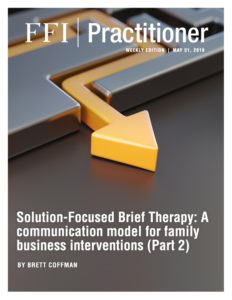
View this edition in our enhanced digital edition format with supporting visual insight and information.
This week’s FFI Practitioner concludes a two-part examination of Solution-Focused Brief Therapy (SFBT), by Brett Coffman. In this week’s edition, Brett addresses the need to look for change in clients and provides a mnemonic device to help remind practitioners about the various techniques associated with SFBT.
My previous article identified and defined Solution-Focused Brief Therapy (SFBT) as an evidence-based model that practitioners can utilize to form a basis for conversations with clients. Languaging was identified as an underlying principle of SFBT and applications to family businesses were presented.1 This article addresses the need to look for change in clients and will introduce a mnemonic device that serves as a pattern of letters to remind the practitioner about different questioning and interaction techniques for use with clients.
Pre-Session Change
Often, when a client engages in a relationship with a practitioner, the client’s mindset has already begun to change prior to the formal interactions that are part of the engagement. Practitioners can identify those changes early in the engagement by asking:
What changes have you noticed that have happened or have started to happen since we started planning for this meeting?
As a result, the client may be able to identify minor improvements. In this case, the practitioner can probe for details to begin the process of “solution-talk,” emphasizing the client’s strengths and resilience, allowing the practitioner to ask:
If these changes were to continue in this direction, would this be what you would like?
Specific Techniques
The SFBT model uses languaging and questioning techniques to build to the miracle question. The mnemonic “MEC-P STAT” can be used to remember each question type and strategy. The questions can be asked in an order that is most appropriate for the situation and leading to the miracle question (Miller & Rollnick, 2002) and don’t all need to be part of every intervention. It takes significant practice to master use these questioning methodologies in an order that is most appropriate to the client situation. In additional, not all techniques are completely independent. For example, scaling questions may be used as part of a series of coping or exception questions.
Miracle Questions
Exception Questions
Coping Questions
Previous Solution Questions
Scaling Questions
Time-Out
Accolades
Task
The SFBT approach does not provide answers; rather, it allows the practitioner to ask questions so that clients derive their own answers. In order to utilize the SFBT Model, it is important to understand how to ask these types of questions, how to listen, and how to apply these questions in a family business setting.
Miracle Questions
The miracle question invites the client to envision and describe in detail how the future will be different when the problem(s) is no longer present. A traditional version of the miracle question could go like this:
“I am going to ask you what may seem like a strange question. After we talk, you will go back to your business (or family) and you will do whatever you need to do for the rest of the day. Eventually, it will be time to go to bed. Everybody in your household is quiet, and you are sleeping in peace. In the middle of the night, a miracle happens and the problem that prompted this discussion is solved. Because this happens while you are sleeping, you have no way of knowing that there was an overnight miracle that solved the problem. When you wake up tomorrow morning, what might be the small change that will make you say to yourself, ‘Wow, something must have happened; the problem is gone?’” (de Shazer, 1982).
The miracle question requires both practice and skill in order to master speaking pace, tone, and pauses. The question must be asked slowly with close attention to the client’s non-verbal communication to ensure that the pace allows the client to follow the question. Initial responses frequently include “I don’t know” responses. To ask questions well, it is crucial to provide the client a respectful silence and some time to fully absorb the question.
Once the small change the client identified through miracle question has been identified, the practitioner can enhance this dialogue with situational scaling questions with a rating on a ten-point scale—where 1 represents worst that things have ever been and 10 represents the miracle day—with questions such as:
- Where are you now?
- How will you know you are 1 point higher?
In this way, the miracle question is not a single question, rather is a series of questions (Pichot, & Dolan, 2003; de Shazer, 1982) where the client is led to think through the small change that can eliminate or significantly diminish the problem. The goal becomes allowing the client to envision large problems being resolved through small changes that they derive.
Exception Questions
The use of exception questions involves inviting the client to consider times when their problem was less severe or absent and addressed in a way that was satisfactory. Exceptions are times when an expected problem did not occur. The client should identify these occurrences to maximize their frequency. Critical questions include:
- What happened that was different?
- What did you do that was different?
Through exception questioning, clients repeat what has worked in the past, receive support for taking baby steps towards their ideal scenarios, and can feel a sense of hope.
In between meetings, rather than giving a task specific to the problem, asking the client to identify “what they want to continue” allows for personal observation and understanding. De Shazer (1982) has described this task as leading to the notion of “exceptions to the rule” when clients enlarge what is working and see the exceptions to the problem.
Coping Questions
Coping questions are designed to elicit information about resources that may go unnoticed by the client to help them feel empowered. Even the most hopeless examples of coping can be given a positive spin:
“I can see how this has been difficult for you. Despite all the problems between family members in the business, have you still managed to oversee successful growth of this business? How have you done that?”
- What happened that was different?
- What did you do that was different?
Genuine curiosity and admiration can help highlight strengths without appearing to contradict the client’s perception of “the problem.” Coping questions start to gently and supportively challenge the problem-focused narrative.
Previous Solution Questions
People have previously solved many problems and likely have some ideas of how to solve the current problem or problems. To help clients see these potential solutions, practitioners may ask:
- Are there times when this has been less of a problem?
- What solutions have been helpful in the past?
Scaling Questions
Whether the client gives specific goals directly or via the miracle question, the next intervention in SFBT is to facilitate self-evaluation that is non-threatening. Scaling questions are useful tools to identify differences for clients. Goals and progress are often measured by subjective scaling allowing internal rigor using natural language:
- What is the worst the problem has ever been?
- Describe the best things could possibly be?
The client is asked to rate his or her current position (e.g., using a 10-point scale). Questions can identify and measure behaviors related to resources and support:
- What’s stopping you from slipping one point lower on the scale?
Clients are then invited to calibrate their own progress precisely:
- On a day when you are one point higher on the scale, what tells you this is a ‘one point higher’ day?
Preferred futures can be discussed:
- What point on the scale is good enough?
- What would a day at that point on the scale feel like? What would you do differently?
Time-Out
Many models of family therapy encourage the practitioner to pause at the end of a meeting to seek feedback from colleagues who have been observing the interaction. Likewise, in SFBT, practitioners are encouraged to seek feedback from a team of external observers. If there is a not a team available, the practitioner can pause to collect his or her thoughts and develop compliments and future exercises/work for the client.
Accolades
Validating what clients are already doing well and acknowledging how difficult their problems are encourages behavior change while showing concern and attention (Berg & Dolan, 2001; Miller & Rollnick, 2002). Using compliments in coaching sessions emphasizes and validates what the client is doing well.
Task
In SFBT, practitioners frequently end meetings by suggesting an experiment or giving homework to the client. These experiments are based on actions, thoughts, or feelings that the client is using to work toward his or her goal. SFBT follows the basic philosophy that the client must identify and solve his or her own problems. Homework may not work as well in other models because it may be challenging and takes considerable thought and effort to accomplish (described as “resistance”). Homework works more often in SFBT because the homework ideas were derived by the client, creating a heightened sense of ownership.
Nudging
There should be gentle nudging to do more of what is working. Once compliments have been used to provide a positive frame, and previous solutions and exceptions have been identified, the client is gently nudged to do more of what works, or to try new experiments. It is unusual for an SFBT practitioner to make a suggestion or assignment that is not based on the client’s previous exceptions. It is always best if the client, rather than the practitioner, identifies ideas and assignments at least indirectly.
Through use of the mnemonic device of MEC-P STAT, practitioners can be empowered to remember a series of techniques that underlay SFBT. Communication is messy. These techniques fall more into the area of art than science and client situations are unique. As a result, other than building toward the miracle question, there is not a specific order or build on to these types of questions. In addition, a practitioner may blend several techniques. By helping clients see exceptions to problems, cope with the difficulties in the family, complete reflective self-assigned homework, and by providing accolades for their successes, clients can be nudged toward those miracles that need to happen in order for their family and businesses to be successful intergenerationally.
Conclusion
SFBT is an empirically based model that can be used by practitioners who seek an empowering solution-focused framework aimed at client solutions. Little has to be known in advance about the presenting problem or causes of the family challenges. The focus is on empowering families and their businesses to envision their preferred future and put into place structures and communication tools that significantly increase the likelihood of success. Clients identify what has worked in the past, identify exceptions to problems, and increase the frequency of useful behaviors. Goals are framed as the presence of a solution and co-constructed by the client and practitioner in a brief timeframe.
References
Berg, I. K., & Dolan, Y. (2001). Tales of solutions: A collection of hope-inspiring stories. New York: WW Norton & Co.
De Shazer, S. (1982). Patterns of brief family therapy: an ecosystemic approach. New York: Guilford Press.
Miller, W. R. & Rollnick, S. (2002). Motivational interviewing: preparing people for change. New York: Guilford Press.
Pichot, T. & Dolan, Y. (2003). Miracles happen: one agency’s journey to look beyond client problems. Binghamton, N.Y.: Haworth.
Swain, M. (1985). Large-scale communicative language testing: A case study. New directions in
language testing, 35-46.
Resources
Institute for Solution-Focused Therapy – www.solutionfocused.net
Solution-Focused Brief Therapy Association – www.sfbta.org
About the Contributors
 Brett Coffman has over two decades of experience advising business owners and is a Fellow at the Family Firm Institute. He earned a B.S. in economics from the University of Utah, an MBA from Syracuse University, a certificate in personal financial planning from New York University, an advanced certificate in family business advising from the Family Firm Institute, and is a Cannon Trust School graduate. In addition, he has a Ph.D. in personal financial planning from Kansas State University, with a focus on family business dynamics and succession preparedness. He is an adjunct professor, has been published in the Journal of Financial Planning, is a reviewer for several academic journals, and has been quoted in regional and national media.
Brett Coffman has over two decades of experience advising business owners and is a Fellow at the Family Firm Institute. He earned a B.S. in economics from the University of Utah, an MBA from Syracuse University, a certificate in personal financial planning from New York University, an advanced certificate in family business advising from the Family Firm Institute, and is a Cannon Trust School graduate. In addition, he has a Ph.D. in personal financial planning from Kansas State University, with a focus on family business dynamics and succession preparedness. He is an adjunct professor, has been published in the Journal of Financial Planning, is a reviewer for several academic journals, and has been quoted in regional and national media.
About BB&T
The Business Advisory services Group of BB&T Wealth is part of BB&T, one of the top 15 largest banks in the United States. Based on the belief that businesses do not transfer successfully by accident, BB&T offers a comprehensive process to help clients create a written plan for succession and address potential contingencies, align all members of their advisory team behind the plan, identify and build the internal leadership team necessary for ongoing success, and fulfill the long-term steps necessary for the ultimate transition plan.

View this edition in our enhanced digital edition format with supporting visual insight and information.




